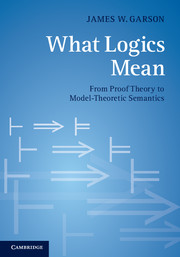Book contents
- Frontmatter
- Dedication
- Contents
- Preface
- Acknowledgements
- 1 Introduction to model-theoretic inferentialism
- 2 Deductive expression
- 3 Local expression
- 4 Global expression
- 5 Intuitionistic semantics
- 6 Conditionals
- 7 Disjunction
- 8 Negation
- 9 Supervaluations and natural semantics
- 10 Natural semantics for an open future
- 11 The expressive power of sequent calculi
- 12 Soundness and completeness for natural semantics
- 13 Connections with proof-theoretic semantics
- 14 Quantifiers
- 15 The natural semantics of vagueness (with Joshua D. K. Brown)
- 16 Modal logic
- Summary
- References
- Index
6 - Conditionals
Published online by Cambridge University Press: 05 June 2014
- Frontmatter
- Dedication
- Contents
- Preface
- Acknowledgements
- 1 Introduction to model-theoretic inferentialism
- 2 Deductive expression
- 3 Local expression
- 4 Global expression
- 5 Intuitionistic semantics
- 6 Conditionals
- 7 Disjunction
- 8 Negation
- 9 Supervaluations and natural semantics
- 10 Natural semantics for an open future
- 11 The expressive power of sequent calculi
- 12 Soundness and completeness for natural semantics
- 13 Connections with proof-theoretic semantics
- 14 Quantifiers
- 15 The natural semantics of vagueness (with Joshua D. K. Brown)
- 16 Modal logic
- Summary
- References
- Index
Summary
The last chapter has paved the way for showing that natural deduction systems for propositional logics express intuitionistic semantics. It is now time to lay out the results connective by connective. We already proved that the natural semantics for S& and S⊥ is classical (Sections 4.1 and 4.2); but intuitionistic semantics agrees with these interpretations of & and ⊥. So it is time to turn to cases where classical and intuitionistic readings differ. We begin with the rules for the conditional → and the biconditional ↔. It is shown that the natural deduction rules S→ for → express the corresponding intuitionistic truth condition ‖→‖ (Section 6.1). So alien anthropologists who learn that S→ describes our deductive behavior must conclude that we assign → the intuitionistic reading (whether we know it or not). In fairness to those who claim that our interpretation of → must be classical, systems that strengthen S→ with Peirce’s Law are then considered (Section 6.2). However, the result of that investigation will be to show that those stronger systems express conditions that are neither classical nor appropriate for defining connective truth conditions. Section 6.3 deals with ↔, and 6.4 provides a summary. These results will supply the basic understanding necessary for handling disjunction (Chapter 7) and negation (Chapter 8) where the situation is more complicated.
- Type
- Chapter
- Information
- What Logics MeanFrom Proof Theory to Model-Theoretic Semantics, pp. 71 - 80Publisher: Cambridge University PressPrint publication year: 2013



